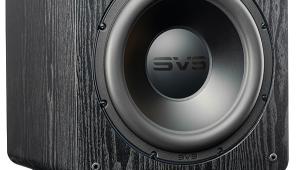Test Report: Martin Logan Motion Vision Soundbar and Dynamo 700W Subwoofer Page 5
Test Bench: Martin Logan Motion Vision Soundbar and Dynamo 700W Subwoofer
Frequency response
- right/left 34 Hz to 20 kHz ±2.5 dB
- center 34 Hz to 20 kHz ±5.3 dB
- subwoofer 28 to 172 Hz ±3 dB
Bass output, subwoofer (CEA-2010A standard)
Ultra-low bass (20-31.5 Hz) average: 96.5 dB
- 20 Hz: 92.3 dB
- 25 Hz: 94.4 dB
- 31.5 Hz: 100.6 dB
Low bass (40-63 Hz) average: 115.2 dB
- 40 Hz: 112.3 dB L
- 50 Hz: 116.3 dB L
- 63 Hz: 116.5 dB L
Bass limits
- soundbar 100.6 dB at 40 Hz
I measured the MotionVision soundbar much as I’d measure separate left/right and center speakers: by feeding a signal to the right channel and placing the microphone 2 meters in front of the right speaker, then feeding a signal into left and right channels and placing the microphone 2 meters in front of the center speaker. I placed the soundbar atop a 2-meter stand and used quasi-anechoic technique to remove the effects of reflections from nearby objects. For both measurements, I adjusted the microphone position for the flattest on-axis response, then averaged the measurements at 0°, ±10°, ±20°, and ±30°, smoothed to 1/12th octave. Bass response of the soundbar was measured using ground plane technique with the microphone on the ground 2 meters from the speaker. I turned the bass level down to where the measured output was comparable to that of the rest of the soundbar’s drivers. The bass measurement was smoothed to 1/3rd octave and spliced to the quasi-anechoic measurements at 300 Hz. I measured the Dynamo 700’s frequency response by close-miking the driver. All frequency response measurements were made with a Clio FW audio analyzer and then imported into a LinearX LMS analyzer for post-processing.
The soundbar measures somewhere between good and amazing, depending on the measurement. The right speaker measurement is remarkably smooth, with no significant flaws and a ±2.5-dB response that even few conventional speakers can achieve. That MartinLogan got this response from a horizontally oriented speaker is especially amazing. Off-axis response is extremely smooth, except for a narrow, 15-dB dip centered at 2.9 kHz that appears at 30° to the speaker’s right side and 45° and 60° to the speaker’s left side.
The center speaker’s not quite as smooth, due to interactions between the two midwoofers. Its averaged response is marred mainly by a dip at 2.7 kHz, which could take a bit of the life out of voices. But still, ±5.3 dB is really good, especially considering I had to feed the unit an analog left+right signal and go through the soundbar’s internal matrix decoder, which probably altered the test signal a bit. Off-axis, a dip of -12 to -15 dB appears between 2.5 and 2.9 kHz, depending on the off-axis angle, at angles of 20° and greater.
CEA-2010A output measurements for the Dynamo 700 subwoofer were taken at 3 meters and then scaled up 9.54 dB per CEA-2010A requirements so that they are equivalent to 1-meter results. Measurements that were dictated by the unit’s internal limiter are designated with an “L” after the dB result. The output is quite decent for such a small subwoofer, averaging 115.2 dB in the low bass (40-63 Hz) and 96.5 dB in the ultra-low bass (20-31.5 Hz). I’m especially impressed that it delivered measurable output down to 20 Hz. The combined low-pass function of the driver, box, and internal crossover measured -18 dB/octave with the crossover set to 80 Hz.
But I’m even more impressed with the bass output of the soundbar, which I measured using CEA-2010 technique. It puts out more than 100 dB down at 40 Hz, which must be a first for a one-piece soundbar. Output falls quickly below that, to 85.8 dB at 31.5 Hz, but still….— Test Bench by Brent Butterworth





























































